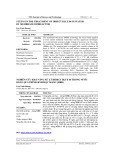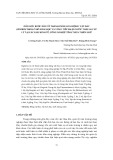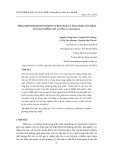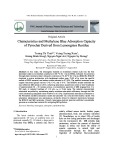
ISSN: 2615-9740
JOURNAL OF TECHNICAL EDUCATION SCIENCE
Ho Chi Minh City University of Technology and Education
Website: https://jte.edu.vn
Email: jte@hcmute.edu.vn
JTE, Volume 19, Issue 03, 2024
49
Eco-Friendly PVA/Starch/Rice Husk Char Coating For Controlled Release
Fertilizers
Thi Lien Nguyen, Minh Ngoc Truong, Thanh Binh Le*
National Center for Technological Progress in Ho Chi Minh City (NaCenTech HCM), Vietnam
* Corresponding author. Email: thanhbinhbio99@gmail.com
ARTICLE INFO
ABSTRACT
Received:
30/04/2024
This research explores the development of a novel slow-release fertilizer
coating composed of polyvinyl alcohol (PVA), tapioca starch, and
modified rice husk char. The study focuses on the optimal production of
rice husk char at 600°C, which facilitates enhanced silica and reduced
carbon contents, improving its functional properties in the coating matrix.
The incorporation of rice husk char into the PVA/starch blend significantly
alters the film's structural and chemical characteristics, as confirmed by
FTIR analysis, which showed increased Si-O bonding. The coatings
effectively reduced moisture absorption by approximately 50% in
comparison to uncoated di-ammonium phosphate (DAP) granules,
demonstrating superior protective qualities. Additionally, nutrient release
profiles indicated a controlled release over 24h, which is critical for
reducing environmental leaching. These results underscore the potential of
using rice husk char in biopolymer coatings to enhance the environmental
performance of fertilizers, offering a sustainable approach to agricultural
management.
Revised:
18/05/2024
Accepted:
13/06/2024
Published:
28/06/2024
KEYWORDS
Slow-release;
Biodegradable;
Coatings;
Rice husk char;
Moisture protection.
Doi: https://doi.org/10.54644/jte.2024.1580
Copyright © JTE. This is an open access article distributed under the terms and conditions of the Creative Commons Attribution-NonCommercial 4.0
International License which permits unrestricted use, distribution, and reproduction in any medium for non-commercial purpose, provided the original work is
properly cited.
1. Introduction
The use of fertilizers plays a crucial role in improving crop yields and meeting the growing food
demand of an ever-increasing global population. However, the excessive and inefficient application of
conventional fertilizers can lead to substantial nutrient losses, environmental pollution, and detrimental
effects on human health [1], [2]. To mitigate these issues, controlled-release or slow-release fertilizers
(SRFs) have emerged as a promising solution, offering a more efficient and environmentally friendly
approach to nutrient management [3].
Slow-release fertilizers are designed to release nutrients gradually over an extended period, reducing
the risk of nutrient leaching, volatilization, and environmental contamination [4]. These fertilizers can
be broadly categorized into two main types: non-coated SRFs, which rely on inherent chemical or
physical properties to control the release rate, and coated SRFs, which employ protective coatings or
encapsulation techniques to regulate nutrient release [5].
Among the various coating materials explored for SRF development, polymers have garnered
significant attention due to their ability to form semi-permeable membranes that control nutrient
diffusion [6]. However, conventional petroleum-based polymers raise concerns due to their non-
biodegradability and potential environmental impact. As a result, there is a growing interest in
developing biodegradable and eco-friendly polymer coatings derived from renewable and sustainable
sources [7].
Biopolymers such as starch, polyvinyl alcohol (PVA), and natural fibers have emerged as promising
candidates for SRF coatings owing to their biodegradability, low toxicity, and environmental
compatibility [8], [9]. Starch, a naturally abundant and inexpensive biopolymer, has been extensively
studied for its potential in controlled-release applications due to its film-forming ability and
biodegradability [10]. When combined with other biopolymers like PVA, starch can form hybrid
coatings with improved mechanical strength and controlled permeability [11]. Additionally, the

ISSN: 2615-9740
JOURNAL OF TECHNICAL EDUCATION SCIENCE
Ho Chi Minh City University of Technology and Education
Website: https://jte.edu.vn
Email: jte@hcmute.edu.vn
JTE, Volume 19, Issue 03, 2024
50
incorporation of natural fillers like rice husk ash can further enhance the coating properties and
potentially provide additional benefits, such as adsorption or ion-exchange capabilities [12].
Rice husk, a byproduct of rice milling, is an abundant and underutilized agricultural residue. It is
composed primarily of organic compounds like cellulose, hemicellulose, and lignin, along with a
significant amount of inorganic silica (around 20%) [13]. By subjecting rice husk to controlled pyrolysis
or combustion, the organic components can be removed, leaving behind a carbon-rich material known
as rice husk char or ash, which retains a high silica content [14]. The silica present in rice husk char
possesses unique properties, including a high surface area, porous structure, and potential for ion-
exchange and adsorption. These characteristics make rice husk char an attractive filler material for SRF
coatings, as it can impart controlled porosity, enhance nutrient adsorption, and potentially improve the
overall performance and longevity of the coating system [12].
This research aims to develop an eco-friendly and biodegradable coating system for slow-release
fertilizers by combining starch, PVA, and rice husk char. The proposed coating formulation leverages
the unique properties of each component to create a multi-functional barrier that regulates nutrient
release while offering environmental compatibility and potential value-added benefits.
2. Materials and Methods
Preparation of Biochar from Rice Husk
Rice husk was first thoroughly washed with water and naturally air-dried, followed by oven-drying
at 100°C for 2 h. The dried husks were then placed into sealed 304 stainless steel tubes (42 mm diameter,
150 mm length) with clay-sealed caps to limit oxygen exposure. The tubes were heated in a Nabertherm
furnace (Germany) to examine the effects of temperature on the biochar quality. The temperature
settings explored were 500°C, 600°C, 700°C, and 800°C with a heating rate of 400°C/h and a dwell time
of 4 h at the peak temperature. After treatment, the obtained biochar was cooled and ground.
Extraction of Silica from Rice Husk Biochar
Silica was extracted from the biochar using alkaline treatment to convert it into soluble sodium
silicate, facilitating plant absorption. Three grams of biochar were added to 30 mL of sodium hydroxide
(NaOH) solution at concentrations of 0.1 M, 0.5 M, 1.5 M, 2 M, and 2.5 M. The mixture was shaken
intermittently at 150 rpm for 6 h (three sessions of 2 h each, with 2-hour intervals) and then left to stand
for 24 h. Post-extraction, the mixture was centrifuged at 7168 rcf for 5 minutes and filtered to separate
the undissolved biochar. The filtrate was diluted and the effective silicon content was measured using
UV-Vis molecular absorption spectroscopy according to TCVN 11407-2019 at 800 nm wavelength. The
biochar residue was further analyzed using Fourier-transform infrared spectroscopy (FTIR) and
scanning electron microscopy (SEM).
Acid Hydrolysis of Fused Phosphate Fertilizers
Fused phosphate fertilizers were reacted with sulfuric acid (H2SO4), hydrochloric acid (HCl), and
nitric acid (HNO3) in varying equivalent concentrations. Ten grams of fused phosphate was treated with
100 mL of each acid solution at 0.5 N, 1.0 N, and 2.0 N dilutions. The samples were agitated
intermittently at 150 rpm for 6 h (three sessions of 2 h each, with 2-hour intervals) and then left to rest
for 24 h. Following incubation, the mixtures were centrifuged at 7168 rcf for 5 minutes and filtered. The
P2O5 content in the filtrates was determined using UV-Vis spectroscopy according to TCVN 10678:2015
at a wavelength of 831 nm.
Preparation of PVA/Starch/Biochar Slow-Release Fertilizer Coating
Starch (7 g) was mixed with 70 mL of distilled water and heated to 90°C at 500 rpm for 1 hour to
achieve complete gelatinization. Separately, PVA (3 g) was swollen under stirring in 30 mL of water
for 10 minutes, then heated to 80°C for 2 h until completely dissolved. Both mixtures were cooled to
room temperature (~30°C), combined, and stirred at 60°C for 2 h to form a homogeneous PVA/starch
mixture.
Rice husk char (3 g) was mixed with 100 mL of 1 M NaOH and shaken horizontally at 150 rpm for
6 h (three 2-hour intervals with 2-hour breaks in between), followed by resting for 24 h. The mixture
was then neutralized and stirred for 1 hour to form a gel with a neutral pH (6-8). This gel was added to

ISSN: 2615-9740
JOURNAL OF TECHNICAL EDUCATION SCIENCE
Ho Chi Minh City University of Technology and Education
Website: https://jte.edu.vn
Email: jte@hcmute.edu.vn
JTE, Volume 19, Issue 03, 2024
51
four separate PVA/starch blends above so that the mass of char was 3%, 6%, 9%, and 12% of the
(PVA+starch) solid mass (correspondingly labeled as C3, C6, C9, and C12, respectively. A control
sample (C0) contained no biochar. To initiate crosslinking, 5 mL of 0.25 M ammonium persulfate (APS)
solution was added to each blend, and the mixtures were stirred at 500 rpm at 60°C for 1 hour, then
heated to 80°C to promote the reaction between the starch and PVA over 2 h. Subsequently, 0.5 mL of
formaldehyde solution was added, and the mixture was stirred at 500 rpm at 80°C for 3 h to form
crosslinks in the film. Finally, 1 mL of glycerol was mixed in and stirred for 2 h [15]..
The final mixtures were sonicated to remove air bubbles and cooled to about 30°C. A portion of each
mixture was poured into plastic Petri dishes lined with silicone paper to dry naturally, forming the films.
The remainder was stored in airtight containers for use as a coating for DAP fertilizer granules.
Coating DAP fertilizer granules
A drying oven and plastic Petri dishes lined with silicone paper were prepared. Two grams of size-
sorted and oven-dried DAP granules were placed into a 50 mL glass beaker. The granules were quickly
dipped into the coating mixture for 1 second, touched against the beaker walls three times to remove
excess coating, and then partially dried using a handheld hair dryer. After coating all the granules, they
were placed in an oven at 60°C for 1 hour. This process was repeated twice more. After the third
application, the coated granules were dried for 2 h at 60°C.
Moisture Absorption Study
The moisture absorption capacity (MAC) of both coated and uncoated fertilizer was assessed. A
specific quantity of fertilizer was weighed (mo) and placed on a pre-weighed dry Petri dish. The setup
was then placed in a sealed container with a saturated NaCl solution, maintaining a relative humidity
(RH) of 75%. After 12 h, the fertilizer was weighed again (m1). The moisture absorption level was
calculated using the formula:
1
1
(%) 100
o
mm
MAC m
(1)
Nutrient Release Study in Water
The release of nutrients from the fertilizer, specifically phosphorus pentoxide (P2O5), was evaluated
for both coated and uncoated samples. Two grams of each type of fertilizer were placed in 100 mL of
distilled water. The mixture was agitated at 150 rpm on a horizontal shaker. Every 2 h, a 1 mL sample
was withdrawn and analyzed for dissolved P2O5 concentration according to TCVN 10678:2015. This
process continued for a duration of 24 h.
3. Results and Discussion
3.1. Silica extraction from rice husks
3.1.1. Effect of Temperature on Rice Husk Char Properties
The formation of rice husk char via pyrolysis in an anaerobic environment showed significant
dependence on temperature, particularly affecting the carbon and silicon content of the char. Preliminary
compositional analysis via Energy Dispersive X-ray Spectroscopy (EDS) indicated distinct variations
in elemental composition with temperature changes (Table 1).
Table 1. Elemental composition of rice husk char at different temperatures.
Temperature (oC)
C
O
Si
K
Raw Husk
52.63 ± 1.99
43.33 ± 1.69
1.71 ± 1.94
0.47 ± 0.10
500
78.88 ± 21.52
28.18 ± 19.74
2.78 ± 2.70
0.70 ± 0.69
600
65.55 ± 9.87
26.67 ± 7.82
7.06 ± 2.89
0.44 ± 0.21
700
65.42 ± 18.97
27.51 ± 14.30
6.28 ± 4.57
0.42 ± 0.18
800
48.13 ± 3.34
40.47 ± 2.82
10.68 ± 1.02
0.63 ± 0.12

ISSN: 2615-9740
JOURNAL OF TECHNICAL EDUCATION SCIENCE
Ho Chi Minh City University of Technology and Education
Website: https://jte.edu.vn
Email: jte@hcmute.edu.vn
JTE, Volume 19, Issue 03, 2024
52
As the temperature increased to 500°C, the oxygen content decreased while the content of other
elements increased possibly due to the loss of water. As the temperature continued to rise to 800 oC, the
carbon content decreased because of the release of CO2 and other organic compounds from the
breakdown of the cellulosic components in the rice husk (cellulose, hemicellulose, and lignin) [16].
Importantly, the silicon content increased with higher temperatures, because silicon does not form
volatile compounds that would be lost.
In the next stage of silica extraction, the silica content in the char should be high and the carbon
content should be low. This allows NaOH to effectively access the silica. However, after the silica is
extracted, the remaining solid will be mainly carbon, which contribute to the composition of the fertilizer
coating. So a high carbon content in the char after pyrolysis is also desirable. To balance these competing
factors, the researchers chose 600°C as the optimal pyrolysis temperature. This allowed for efficient
silica extraction while also retaining a useful amount of carbon in the final char.
3.1.2. Silica Extraction from Rice Husk Char Using NaOH
The extraction of silica from the rice husk biochar was based on the following reaction:
SiO2 + 2NaOH → Na2SiO3 + H2O
(2)
Fig. 1 shows that the silica extraction efficiency increased with NaOH concentration, plateauing
beyond 1.0 M, indicating minimal additional benefits from higher concentrations. The reason for this
plateau is that when silica in the char dissolved enough to form a silicate solution with a moderate
concentration, the high viscosity of the silicate-rich mixture made it increasingly difficult to dissolve
any further silica. Thus, 1 M NaOH was determined to be the most effective concentration for silica
extraction.
Figure 1. Effect of NaOH concentration on percentage of SiO2 extracted from rice husk char.
3.1.3. SEM and FTIR Analysis of NaOH-Treated Rice Husk Char
Figure 2. FTIR spectra of untreated biochar and biochar after treated with different NaOH concentrations.

ISSN: 2615-9740
JOURNAL OF TECHNICAL EDUCATION SCIENCE
Ho Chi Minh City University of Technology and Education
Website: https://jte.edu.vn
Email: jte@hcmute.edu.vn
JTE, Volume 19, Issue 03, 2024
53
During the extraction of silicate from rice husk ash, structural modifications and functional group
changes were observed. To assess these changes, Fourier Transform Infrared Spectroscopy (FTIR) was
employed across a wavelength range of 4000 cm-1 to 400 cm-1 to identify alterations in specific bonds
(Fig. 2). The presence of a Si-O bond was indicated by peaks approximately at 793.33 cm-1 and 1055.3
cm-1, while the peak at 1650 cm-1 corresponded to O-H bonds in adsorbed water molecules and silanol
groups [17].
Fig. 2 displays that the increase in concentration of NaOH led to a gradual decrease in the peak
intensities of Si-O bonds and an increase in those of Si-O-H bonds. This suggests that as NaOH
concentration increases, the silica content in the rice husk ash powder decreases.
Scanning Electron Microscopy (SEM) was used to observe the structural changes in the surface of
rice husk ash before and after modification with various concentrations of NaOH. Figure 3a depicts the
original surface structure of the rice husk char, which is characterized by clear framework outlines and
few pores. However, Fig. 3b shows partial destruction of this structure, with a loss of the surface
contours. In Fig. 3c, these contours were almost lost, and numerous pores appear on the surface. The
loss of contours and appearance of pores are attributed to the strong dissolution of silica at high NaOH
concentrations [18].
3.2. Effect of Acid Concentration on Phosphate Extraction
Phosphate extraction from fused phosphate fertilizers was influenced by the type and concentration
of acid used, with HCl and HNO3 showing superior dissolution capabilities compared to H2SO4 (Table
2). The use of 2 N HNO3 was favored due to its ability to dissolve the highest amount of P2O5 and
provide nitrogen to the plants. A more concentrated HNO3 may dissolve more P2O5, but the low volume
required to neutralize the fused phosphate fertilizer would make the mixture too viscous to agitate
effectively. These findings support the potential use of extracted phosphate solutions in combination
with silica gel from rice husk char for developing slow-release fertilizer coatings.
Table 2. Percentage of P2O5 dissolved from phosphate fertilizer by acid type and concentration.
Concentration (N)
H2SO4
HCl
HNO3
0.5
1.77 ± 0.85
2.55 ± 0.69
1.82 ± 0.72
1.0
1.94 ± 0.72
4.30 ± 0.71
3.69 ± 0.63
2.0
3.68 ± 0.89
4.99 ± 0.89
4.97 ± 0.82
After hydrolyzing fused phosphate fertilizer, we obtained a solution with a high P2O5 content. This
solution was used to neutralize the mixture of rice husk char in NaOH. The resultant mixture comprised
poorly soluble salts, specifically MeNH4PO4.H2O (where Me represents Mg, Fe, Zn, Mg, or K) and
silicon-phosphate gel (Si3(PO4)4). Some forms of silica that exhibit strong binding capabilities with
phosphate show potential for application as coatings in slow-release fertilizers [19].
(a)
(b)
(c)
Figure 3. SEM micrographs of rice husk biochars (a) untreated, (b) treated with 0.1 M NaOH (c) and
treated with 1.0 M NaOH.






![Câu hỏi ôn tập Vi sinh môi trường [năm hiện tại]](https://cdn.tailieu.vn/images/document/thumbnail/2025/20250710/kimphuong1001/135x160/8671752134731.jpg)





![Tài liệu Vi sinh vật môi trường [Mới nhất]](https://cdn.tailieu.vn/images/document/thumbnail/2025/20251123/ngkimxuyen/135x160/21891763953413.jpg)
![Sổ tay truyền thông Phân loại chất thải rắn sinh hoạt trên địa bàn tỉnh Quảng Nam [Chuẩn nhất]](https://cdn.tailieu.vn/images/document/thumbnail/2025/20251114/kimphuong1001/135x160/1701763094001.jpg)


![Quản lý chất thải nguy hại: Sổ tay Môi trường [Chuẩn nhất]](https://cdn.tailieu.vn/images/document/thumbnail/2025/20251029/kimphuong1001/135x160/9011761720170.jpg)









